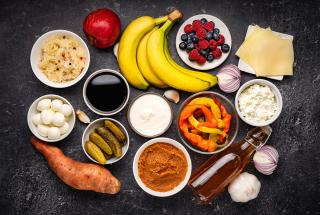Prebiotics vs. Probiotics: What’s the Difference?
More than 2,000 years ago, Hippocrates, considered to be the Father of Medicine, once made the claim that all disease begins in the gut. In more recent years, there has been a large number of scientific articles that prove his point—at least when it comes to metabolic diseases like heart disease and diabetes.
Considering 70% of the immune system is in the gut, and the effects of poor gut health span everything from inflammation to diabetes and some cancers, prioritizing gut health and improving your microbiome can help you make strides in your health and wellness journey. You can do this by making sure you are consuming enough prebiotic and probiotic foods. Learn more about symptoms of gut imbalance, the difference between prebiotics and probiotics, and how to get your microbiome back on the right track.
Common Symptoms of Gut Issues
A 2022 survey conducted by the New American Gastroenterological Association found that almost half of Americans' daily lives are disrupted by gut troubles. Gut issues is a loose term that explains many digestive problems, including leaky gut, constipation, irritable bowel syndrome (IBS), nausea, food poisoning, gas, bloating, GERD, and diarrhea.
Those pesky symptoms of gut issues are sending a message: Your gut is having a hard time processing and absorbing nutrients from your food and eliminating waste. Here are some signs you may suffer from poor gut health:
- Frequent discomfort or upset stomach
- Fatigue
- Diarrhea
- Heartburn
- Gas
- Bloating
- Unexplained weight gain or weight loss
- Inflammation or achy joints
- Skin irritations (acne, eczema, psoriasis, rashes)
- Frequent headaches
- Acid reflux/heartburn
- Extreme sugary food cravings
- Autoimmune problems
- Irritability and frequent mood changes
- Insomnia/trouble sleeping
- Food intolerances
Probiotics vs. Prebiotics: What’s the Difference?
Think of your gut as a battlefield. The perfect gut (or microbiome) is filled with a bounty of good bacteria to ward off harmful bacteria that create the perfect environment for disease to thrive. Your “good” and “bad” microbes are fighting for domination inside your body. Luckily, with lifestyle changes, you can decide who wins.
By adding as many “good” soldiers as possible, you will overthrow the bad microbes that are in power. If the bad bacteria are currently winning the war inside your tummy—which is especially true if you consume an inflammatory high-sugar diet filled with processed food and simple carbohydrates—you likely have gut dysbiosis. This can look like nutrient malabsorption, high cholesterol, a higher toxin load in the body, hormone and thyroid issues, autoimmune and other disorders, and generally feeling unwell.
Once the good bacteria are back in charge, they can begin the incredible work of healing your gut, repairing your metabolism and metabolic health, improving digestion and nutrient absorption, producing essential vitamins like Vitamin K, B12, and biotin, producing more serotonin (goodbye bad moods!), and improve hormone regulation.
How do we initiate this process? By consuming a diet rich in prebiotics and probiotics. And getting them into your diet is easier than you think.
What Are Prebiotics?
Prebiotics are the fuel for the good bacteria in your gut, otherwise known as probiotics. Prebiotics, also considered prebiotic fiber, are fuel for your “good guys”—they are non digestible food ingredients that promote the growth of beneficial microorganisms in the intestines (bacteria and fungi).
We need prebiotics because, just like us, the good bacteria that live inside us need food to thrive and do their job. So, consuming prebiotic fiber is the perfect way to keep your good gut heroes happy, healthy, and thriving!
Examples of Prebiotics
Prebiotic fiber comes from six main food groups: vegetables, fruit, legumes, nuts and seeds, fresh herbs, and whole grains. The top prebiotic foods are:
- Chicory root
- Dandelion greens
- Jerusalem artichoke
- Garlic
- Onions
- Leeks
- Asparagus
- Bananas
- Barley
- Oats
The Importance of Probiotics on Improving Gut Health
Now that you know how to feed your “good” gut soldiers, it’s time to recruit a bigger army by eating more probiotic foods or the live bacteria and yeast that comprise a healthy microbiome. While many people take probiotic supplements, which may be a necessary measure for quickly improving gut health (after a round of antibiotics, for example), the best way to get probiotics is through a healthy diet. The best probiotic foods include:
- Sauerkraut
- Kimchi
- Tempeh
- Miso
- Kefir
- Yogurt
- Natto
- Sourdough
- Kombucha
Sauerkraut is a probiotic powerhouse, with one tablespoon containing as many as 10 BILLION CFUs (or colony-forming units). A CFU is the number of live and active microorganisms in one serving of a probiotic dietary supplement.
Tips to Improve Gut Health
To keep your gut-guarding army growing and on the winning side, it’s important to practice good gut health by eating a healthy diet and avoiding gut disruptors. While different food groups affect everyone differently, it is generally a good idea to limit or avoid the following to optimize gut health:
- Refined sugar and starches
- Artificial sweeteners
- Alcohol or caffeine in excess
- Processed foods
- Fried foods
- Inflammatory/refined seed oils such as canola or vegetable
Another way to keep your gut in check is to understand what is in the food you are consuming. Discover the five key steps to reading a food label and making informed choices about your diet for building a healthier lifestyle.




